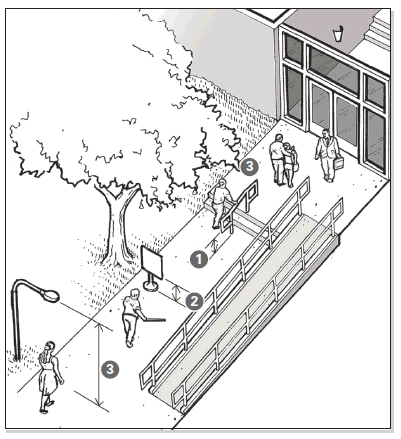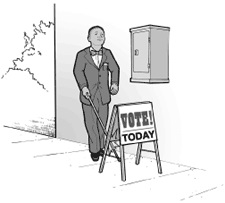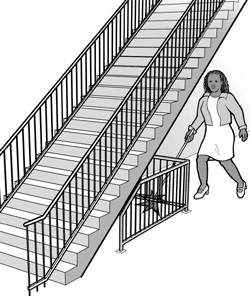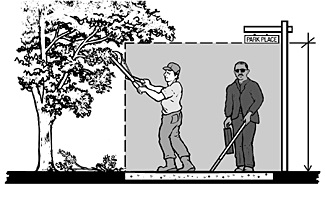Part 2. Typical Issues for Voters Who Are Blind or Have Low Vision
Objects that are wall-mounted, that project into a pedestrian route from the side, or that are overhead must be located so that people who are blind or who have low vision will either detect the objects before they run into them or safely pass under them. Examples include handrail extensions on stairs and ramps, post or wall-mounted signs, outdoor drinking fountains, and tree limbs that are lower than 80 inches above the walk. Pedestrian routes open to voters, such as sidewalks, courtyards, and plazas, must be free of overhanging objects that are less than 80 inches above the route. Objects more than 27 inches and less than 80 inches above the route that protrude from the side more than 4 inches are also a hazard. Because people can walk on any sidewalk, not just the accessible routes, all exterior pedestrian routes serving or leading to the voting area must be checked. The following checklist applies to sidewalks and walkways leading to the polling place and voting area.

Common objects along pedestrian routes to a polling place that can be hazards to people who are blind or have low vision.
Notes:
1. The bottom of the handrail extensions turn down so a person who is blind or has low vision can detect the hazard before running into it.
2. Signs or other objects in the pedestrian route can be a hazard if the bottom is more than 27 inches but less than 80 inches above the route.
3. Objects that overhang the pedestrian route must be at least 80 inches above the route.
C2-1. Are all sidewalks and walkways to the voting area free of any objects (e.g., wall-mounted boxes, signs, handrail extensions, trees) with bottom edges that are higher than 27 inches but less than 80 inches above the walkway and that extend more than 4 inches into the sidewalk or walkway? [ADA Stds 4.4, 4.2.1(3), 4.1.3(2)]
Yes _____ No _____
If No, can the object be lowered, removed, or modified or can the route be changed to avoid the object?

This wall-mounted box is mounted too high to be detectable by a person who is blind. Placing an object, like this sign, under the box provides a way to warn the person before they walk into the side of the box.
C2-2. Are the undersides of exterior stairs enclosed or protected with a cane detectable barrier so that people who are blind or have low vision will not hit their heads on the underside?
[ADA Stds 4.4.2]
Yes _____ No _____
If No, can a barrier or enclosure be added below the stair or can the route be relocated away from the stair?

When the underside of a stair is open, it is a hazard to people who are blind or have low vision. Enclosing the area below the stair or installing a cane-detectable barrier helps the person to stop before hitting her head.
C2-3. Are all objects that hang over the pedestrian routes 80 inches or more above the route?
If No, can the objects be removed or relocated, or can a detectable object be added below?
Yes _____ No _____

At least 80 inches above walk
Temporary Solutions for Election Day
Sidewalks and Walkway Hazards
Problem One: Branches or other objects over a walkway or pedestrian route are lower than 80 inches above the walk.
Suggestion: Prune the branches or remove the items that are hanging below 80 inches. Another approach is to install a detectable barrier under the item that is too low. The detectable barrier or object must be within the detectable range of 27 inches or less above the route.
Problem Two: One or more objects protrude too far from the side into the circulation path causing a hazard for people who are blind or who have low vision.
Suggestion: When people who are blind or who have low vision use a cane to detect hazards, objects located at 27 inches or lower are detectable. When an object is located more than 27 inches off the ground it is a hazard if the object protrudes more than 4 inches into the circulation path. To make a protruding object detectable:
Place an object or a barrier below the protruding object in the cane-detectable area not more than 27 inches above the floor.
If the protruding object can be moved, lower the object so its bottom is within the cane-detectable area (not more than 27 inches above the floor).
Prune or alter the protruding object so it does not protrude over the path.

User Comments/Questions
Add Comment/Question